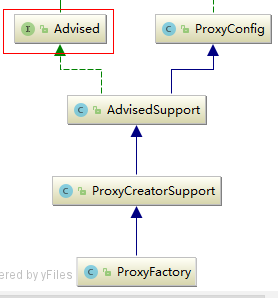回到wrapIfNecessary()方法中,AbstractAutoProxyCreator类中,现在找到了匹配的Advisor类,开始为bean创建代理:
protected Object createProxy(Class<?> beanClass, @Nullable String beanName,
@Nullable Object[] specificInterceptors, TargetSource targetSource) {
//1.创建proxyFactory,proxy的生成主要是在proxyFactory中进行
ProxyFactory proxyFactory = new ProxyFactory();
proxyFactory.copyFrom(this);
if (!proxyFactory.isProxyTargetClass()) {
if (shouldProxyTargetClass(beanClass, beanName)) {
proxyFactory.setProxyTargetClass(true);
}
else {
evaluateProxyInterfaces(beanClass, proxyFactory);
}
}
//2.将当前的bean合适的advice,重写封装一下,封装为advisor类,然后添加到ProxyFactory中
Advisor[] advisors = buildAdvisors(beanName, specificInterceptors);
proxyFactory.addAdvisors(advisors);
proxyFactory.setTargetSource(targetSource); //设置代码对象
customizeProxyFactory(proxyFactory);
proxyFactory.setFrozen(this.freezeProxy);
if (advisorsPreFiltered()) {
proxyFactory.setPreFiltered(true);
}
//3.重点,proxyFactory有jdk和cglib两种,使用DefaultAopProxyFactory的createAopProxy()方法进行选择
return proxyFactory.getProxy(getProxyClassLoader());
}1.new ProxyFactory()
看一下这个类的继承图,父类是ProxyConfig类,它提供的功能就是getProxy()入口,其他主要功能是保存了代理对象的很多信息


3.getProxy()
//位于ProxyFactory类中
public Object getProxy(@Nullable ClassLoader classLoader) {
return createAopProxy().getProxy(classLoader);
}方法拆解,3.1.createAopProxy()方法:来到父类ProxyCreatorSupport类中
protected final synchronized AopProxy createAopProxy() {
return getAopProxyFactory().createAopProxy(this);
}
//深入
public AopProxyFactory getAopProxyFactory() {
return this.aopProxyFactory;
}
//该字段含义:
private AopProxyFactory aopProxyFactory;
//该字段的初始化:
this.aopProxyFactory = new DefaultAopProxyFactory();所以,最后调用了DefaultAopProxyFactory类的 createAopProxy()方法:
用来抉择是使用jdk的代理方式,还是cglib的代理方式,传入的参数this:ProxyCreatorSupport类,ProxyFactory类的父类
public AopProxy createAopProxy(AdvisedSupport config) throws AopConfigException {
// config.isOptimize()是否使用优化的代理策略,目前使用与CGLIB
// config.isProxyTargetClass() 是否目标类本身被代理而不是目标类的接口
// hasNoUserSuppliedProxyInterfaces()是否存在代理接口
if (config.isOptimize() || config.isProxyTargetClass() || hasNoUserSuppliedProxyInterfaces(config)) {
//第二层类的方法,AdvisedSupport类 获得目标代理类的 Class对象 就是目标bean
Class<?> targetClass = config.getTargetClass();
//如果实现了接口,则使用jdk代理,如果没有则使用cglib代理
if (targetClass.isInterface() || Proxy.isProxyClass(targetClass)) {
return new JdkDynamicAopProxy(config);
}
return new ObjenesisCglibAopProxy(config);
}
else {
return new JdkDynamicAopProxy(config);
}
}分类标准很简单,如果使用了接口,则使用Jdk的代理方式,否者使用cglib代理方式
3.2 getProxy()
拿到了AopProxy的实现类之后,调用了getProxy()方法:我们使用jdkDynamicAopProxy分析:
初始化方法:将ProxyCreatorSupport类保存,也就是代理工厂
public JdkDynamicAopProxy(AdvisedSupport config) throws AopConfigException {
this.advised = config;
}执行getProxy()方法,获取代理类要实现的接口,除了Advised对象中配置的,还会加上SpringProxy,Advised(opaque=false)
检查得到的接口中没有定义equals或者hashcode接口
public Object getProxy(@Nullable ClassLoader classLoader) {
//获取完整的 代理 接口
Class<?>[] proxiedInterfaces = AopProxyUtils.completeProxiedInterfaces(this.advised, true);
findDefinedEqualsAndHashCodeMethods(proxiedInterfaces);
return Proxy.newProxyInstance(classLoader, proxiedInterfaces, this);
}该方法的实现是完成走的jdk代理模式,return 中的三个参数是固定的,第一个是加载器,第二个是代理类对应的接口,第三个是this,可以参考代理设计模式:https://blog.csdn.net/W1427259949/article/details/105138669
JdkDynamicAopProxy类实现了InvocationHandler接口,自然走的是代理模式,核心功能在invoke()方法中,advisor的添加也是在该方法中进行注入:实际上,逻辑应该简单,就是把前面匹配出来的Advisor根据相应的注解对应的位置,加到method.invoke()执行的前后,但是spring中间加了一个advisor转interceptor的过程,所以稍显复杂。
public Object invoke(Object proxy, Method method, Object[] args) throws Throwable {
Object oldProxy = null;
boolean setProxyContext = false;
TargetSource targetSource = this.advised.targetSource;
Object target = null;
try {
//目标对象未实现equals()方法
if (!this.equalsDefined && AopUtils.isEqualsMethod(method)) {
return equals(args[0]);
}//目标对象未实现 hashCode()方法
else if (!this.hashCodeDefined && AopUtils.isHashCodeMethod(method)) {
return hashCode();
}
else if (method.getDeclaringClass() == DecoratingProxy.class) {
return AopProxyUtils.ultimateTargetClass(this.advised);
}//直接反射调用advised接口 或者其父接口中定义的方法,不应用通知
else if (!this.advised.opaque && method.getDeclaringClass().isInterface() &&
method.getDeclaringClass().isAssignableFrom(Advised.class)) {
return AopUtils.invokeJoinpointUsingReflection(this.advised, method, args);
}
Object retVal;
if (this.advised.exposeProxy) {
oldProxy = AopContext.setCurrentProxy(proxy);
setProxyContext = true;
}
//获得目标对象的类
target = targetSource.getTarget();
Class<?> targetClass = (target != null ? target.getClass() : null);
//1. 获取可以应用到此方法上的拦截器列表 【入】
List<Object> chain = this.advised.getInterceptorsAndDynamicInterceptionAdvice(method, targetClass);
//2.如果没有可以应用到此方法上的拦截器,则直接反射调用 Method.invoke()
if (chain.isEmpty()) {
Object[] argsToUse = AopProxyUtils.adaptArgumentsIfNecessary(method, args);
retVal = AopUtils.invokeJoinpointUsingReflection(target, method, argsToUse);
}
else {//3. 不为空,则逐一调用chain中的每一个拦截方法的proceed()
// 创建ReflectiveMethodInvocation
MethodInvocation invocation =
new ReflectiveMethodInvocation(proxy, target, method, args, targetClass, chain);
retVal = invocation.proceed(); //执行【入】
}
Class<?> returnType = method.getReturnType();
if (retVal != null && retVal == target &&
returnType != Object.class && returnType.isInstance(proxy) &&
!RawTargetAccess.class.isAssignableFrom(method.getDeclaringClass())) {
retVal = proxy;
}
return retVal;
}
}1.拦截器链的获取:this.advised.getInterceptorsAndDynamicInterceptionAdvice(method, targetClass);
public List<Object> getInterceptorsAndDynamicInterceptionAdvice(Method method, @Nullable Class<?> targetClass) {
MethodCacheKey cacheKey = new MethodCacheKey(method);
List<Object> cached = this.methodCache.get(cacheKey);
if (cached == null) { //【入】
cached = this.advisorChainFactory.getInterceptorsAndDynamicInterceptionAdvice(
this, method, targetClass);
this.methodCache.put(cacheKey, cached);
}
return cached;
}继续进入,这里只是一个入口:
public List<Object> getInterceptorsAndDynamicInterceptionAdvice(
Advised config, Method method, @Nullable Class<?> targetClass) {
// This is somewhat tricky... We have to process introductions first,
// but we need to preserve order in the ultimate list.
List<Object> interceptorList = new ArrayList<Object>(config.getAdvisors().length);
Class<?> actualClass = (targetClass != null ? targetClass : method.getDeclaringClass());
//查看是否包含IntroductionAdvisor
boolean hasIntroductions = hasMatchingIntroductions(config, actualClass);
//这里实际注册了一系列 AdvisorAdapter,用于将Advisor转换成MethodInterceptor
AdvisorAdapterRegistry registry = GlobalAdvisorAdapterRegistry.getInstance();
for (Advisor advisor : config.getAdvisors()) {
if (advisor instanceof PointcutAdvisor) {
// Add it conditionally.
PointcutAdvisor pointcutAdvisor = (PointcutAdvisor) advisor;
if (config.isPreFiltered() || pointcutAdvisor.getPointcut().getClassFilter().matches(actualClass)) {
MethodMatcher mm = pointcutAdvisor.getPointcut().getMethodMatcher();
if (MethodMatchers.matches(mm, method, actualClass, hasIntroductions)) {
//将advisor 转换成 Interceptor
MethodInterceptor[] interceptors = registry.getInterceptors(advisor);
//检查当前Advisor的切入点,是否可以匹配当前方法
if (mm.isRuntime()) {
// Creating a new object instance in the getInterceptors() method
// isn't a problem as we normally cache created chains.
for (MethodInterceptor interceptor : interceptors) {
interceptorList.add(new InterceptorAndDynamicMethodMatcher(interceptor, mm));
}
}
else {
interceptorList.addAll(Arrays.asList(interceptors));
}
}
}
}
else if (advisor instanceof IntroductionAdvisor) {
IntroductionAdvisor ia = (IntroductionAdvisor) advisor;
if (config.isPreFiltered() || ia.getClassFilter().matches(actualClass)) {
Interceptor[] interceptors = registry.getInterceptors(advisor);
interceptorList.addAll(Arrays.asList(interceptors));
}
}
else {
Interceptor[] interceptors = registry.getInterceptors(advisor);
interceptorList.addAll(Arrays.asList(interceptors));
}
}
return interceptorList;
}获得拦截器链之后,开始执行
2.无拦截器,直接执行方法
public static Object invokeJoinpointUsingReflection(@Nullable Object target, Method method, Object[] args) {
// Use reflection to invoke the method.
try {
ReflectionUtils.makeAccessible(method);
return method.invoke(target, args);
}
}3.执行拦截器链
public Object proceed() throws Throwable {
//如果拦截器执行完了,则执行拦截点
if (this.currentInterceptorIndex == this.interceptorsAndDynamicMethodMatchers.size() - 1) {
return invokeJoinpoint();
}
Object interceptorOrInterceptionAdvice =
this.interceptorsAndDynamicMethodMatchers.get(++this.currentInterceptorIndex);
if (interceptorOrInterceptionAdvice instanceof InterceptorAndDynamicMethodMatcher) {
InterceptorAndDynamicMethodMatcher dm =
(InterceptorAndDynamicMethodMatcher) interceptorOrInterceptionAdvice;
//动态匹配,运行时参数是否满足条件
if (dm.methodMatcher.matches(this.method, this.targetClass, this.arguments)) {
return dm.interceptor.invoke(this);
}
else { //动态匹配失败,略过当前拦截器,执行下一个
return proceed();
}
}
else { //执行当前拦截器
return ((MethodInterceptor) interceptorOrInterceptionAdvice).invoke(this);
}
}链路的执行,向栈一样,递归调用方法,而不是简单的for()循环调用,比如AfterReturningAdviceInterceptor类中:
public Object invoke(MethodInvocation mi) throws Throwable {
Object retVal = mi.proceed(); //先递归调用,
//调用完毕之后,再需要方法
this.advice.afterReturning(retVal, mi.getMethod(), mi.getArguments(), mi.getThis());
return retVal;
}而MethodBeforeAdviceInterceptor类中,它的方法就是先调用的
public Object invoke(MethodInvocation mi) throws Throwable {
this.advice.before(mi.getMethod(), mi.getArguments(), mi.getThis());
return mi.proceed();
}到这里,aop的原理,我们就告一段落了!
参考链接:https://blog.csdn.net/qq_26323323/article/details/81012855






















 436
436











 被折叠的 条评论
为什么被折叠?
被折叠的 条评论
为什么被折叠?








